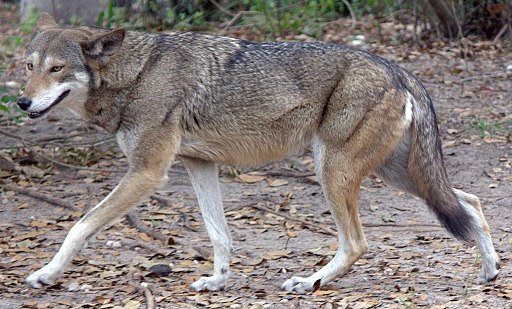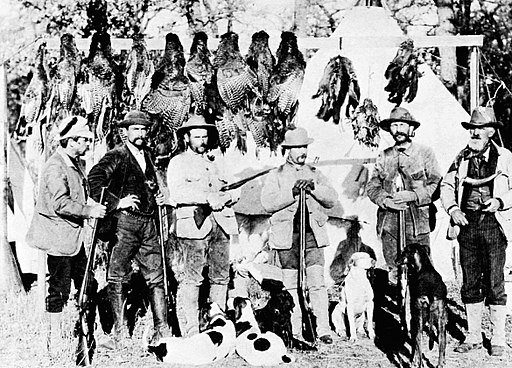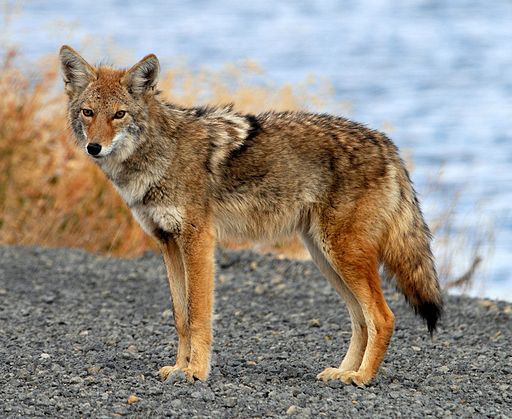How Coyotes Are Killing The Red Wolves
I am an alum of Arkansas State University, the proud home of the Red Wolves! However, we weren’t known as Red Wolves back when I was in school; we were the ASU Indians. But, the times, they were a-changin’. By my senior year, the whisperings of a mascot change were prevalent, and in 2008, ASU officially changed their name to the Red Wolves. At first, people were confused. There are no wolves in Arkansas! And, they were correct: there aren’t any wolves in Arkansas… any more.
.jpg)
Image Credit
Canis rufus: The North American Red Wolf
Arkansas was once home to the red wolf, a species of wolf endemic to the the United States. Reaching up to 80 pounds, the red wolf is a fairly large canid species; larger than a coyote but smaller than the gray wolf. At one time, it roamed throughout the Eastern US, ranging as far north as Pennsylvania, and as far west as Texas. Then, humans entered the picture. Early European settlers saw the abundance of wildlife in the American Forests as an endless resource. Many lynchpin species were nearly wiped out. Whitetail deer numbers in Arkansas dipped down to as low as a few hundred individuals. The black bear population dropped down to fewer than 100.
Image Credit
The red wolf shared their fate. Not only was it hunted for its rusty red tinged pelt, it also suffered habitat and food loss, as its main food source was the whitetail deer. By the 1960s, it had been declared extinct in the state. Unfortunately, it didn’t fare much better anywhere else. In the late 1960s, the U.S. Fish & Wildlife Service began an effort to bring the red wolf back. They began capturing wild wolves and testing them for genetic purity. Of the over 400 animals captured, they were only able to release 14 back into the wild to breed. The rest had hybridized with other canid species like the coyote. They were actually declared extinct by the Fish & Wildlife Service in 1908. Fortunately, those few animals were able to thrive, and today, around 100 individuals live in the wild with another 200 or so kept in captive breeding programs. It would seem that things are looking up for the North American Red Wolf!
 Image Credit
Image CreditCanis latrans: The Coyote
The coyote is the smaller cousin of the gray and red wolves, usually maxing out at around 45 pounds or so.They are a skittish, yet intelligent and highly adaptive species. Historically, the coyote’s range was limited to the plains and arid regions of the American midwest all the way down through Mexico. However, starting in the late 1800s, coyotes began a great migration that would spread them throughout all of North America. Now, coyotes can be found in 49 of the 50 U.S. states, with Hawaii being the lone coyote-free territory. But, how were they able to become so widespread?The Plight of The Coyote
The coyote seems to be one of the most hated animals in North America. In fact, humans have been trying to eradicate them since the 1800s. Miraculously, these sly animals have not only survived our efforts, but as Dan Flores points out, they have thrived because of them!Dan was a guest on episode #942 of The Joe Rogan Experience podcast. While on the show, he explained how coyotes became so adept at survival. He believes that today’s North American gray wolf population migrated in somewhere around 24,000 - 70,000 years ago (a stance shared by the U.S. Fish & Wildlife Service). Upon their arrival, they began to torment the local, smaller canid species like coyotes. They were forced to learn to adapt to pressure, so this new human is really isn’t all that new to them.
The Coyote Survival Strategy
In the podcast, Dan Flores points out several different survival strategies that coyotes employ. He mentions that some of their vocalizations are actually a roll call. Any time a member of the pack doesn’t check in for roll call, the females of the group tend to undergo some hormonal changes that encourage them to produce larger litters. In effect, if one coyote is killed by predators or hunters, it may be replaced by several others. Another strategy is what Dan referred to as a fission-fusion adaptation. In the absence of pressure, coyotes are pack animals. They form very organized and stable societies that tend to have defined territorial boundaries. However, when threatened, the pack will splinter into small groups, and each will migrate to a new home to start a new pack. So, the more we try to kill it, the faster it spreads.Worlds Collide
Now, remember the North American red wolf. Remember how it seems to be a species on the rise, going from a measly 14 individuals to nearly 100 within a couple of decades after the human threat was removed. But, now a new threat looms. As the coyote encroaches on red wolf territory, the chances for survival of the red wolf plummet. It’s not that the coyote poses a physical threat to the red wolf. It’s not that there is a lack of food. The problem is that the two species are closely enough related that they are able to interbreed, which destroys the genetic purity of the species.But, hope is again on the horizon. Now that scientists are beginning to understand how hunting the coyote is counterproductive, they are beginning to develop new strategies. In areas where the red wolf is attempting its comeback, researchers have begun collecting coyotes, sterilizing them, and releasing them back into the wild. They have found that the sterile coyotes still guard their territory, keeping other coyotes from entering the area. Their hope is that they will be able to reduce the breeding population of coyotes to the point where the red wolf will be able to successfully reproduce.I, for one, hope this strategy works. I would love to one day be able to catch a glimpse of an Arkansas Red Wolf in the wild.
Sources
Red Wolves: An Endangered Species In Peril
Episode #942 of The Joe Rogan Experience
Joplin Globe Article
Defenders.org
Encyclopedia of Arkansas: Black Bears
Encyclopedia of Arkansas: Official State Mammal
Urban Coyote Research Project
National Geographic Article
BBC Earth Article
U.S. Fish & Wildlife Red Wolf Recovery Project
.jpg)
You received a 60.0% upvote since you are a member of geopolis and wrote in the category of "ecology".
To read more about us and what we do, click here.
https://steemit.com/geopolis/@geopolis/geopolis-the-community-for-global-sciences-update-4
Interesting, I had actually never heard of a red wolf. They were found all the way over in PA back in the day eh? Maybe someday conservation efforts will be able to restore their populations to it's former glory.
I honestly hadn't either until the college changed its mascot. It's crazy to imagine being an early settler with such large predators around.
Although I am always on the side of preserving the species, I am also against sterilization of animals, so I am not certain what should be done in this situation.
Very interesting article I would like to see how the program is also supporting the food chain to support the overall efforts to set them up again in the habitats.
I know here in Arkansas, the Arkansas Game & Fish Commission has done a wonderful job rehabilitating the whitetail deer, which was one of the red wolf's main food sources, and the surrounding states are full of deer, as well. A lot of it is managed through managing hunting seasons.
I'm happy to hear that. Hunting is prohibit in Costa Rica and sanctions are very strong. Well after all we want to primarily focus on the environment, animals, nature and tourism loves it that way.
Nice work on this article! I find the coyote survival strategy part truly fascinating.
Thank you! You should check out that Joe Rogan podcast. It is super interesting.
I wrote a similar peice a few days ago. I guess it's inevitable that their genetic purity will ultimately be disrupted in the long run
I remember hearing about the liger in the movie Napoleon Dynamite and being surprised when I looked it up and it was real! There's also an interesting documentary about the coywolf that use to be on Netflix. I'm not sure if its still available for online streaming.
GOod JoB brO.
WelL DonE.
thankS foR shareinG 😊
Being A SteemStem Member
for the first time, I am earning things a special kind of wolf wiping out another kind...really??
this is interesting just like we take out the competition in business to have monopoly.